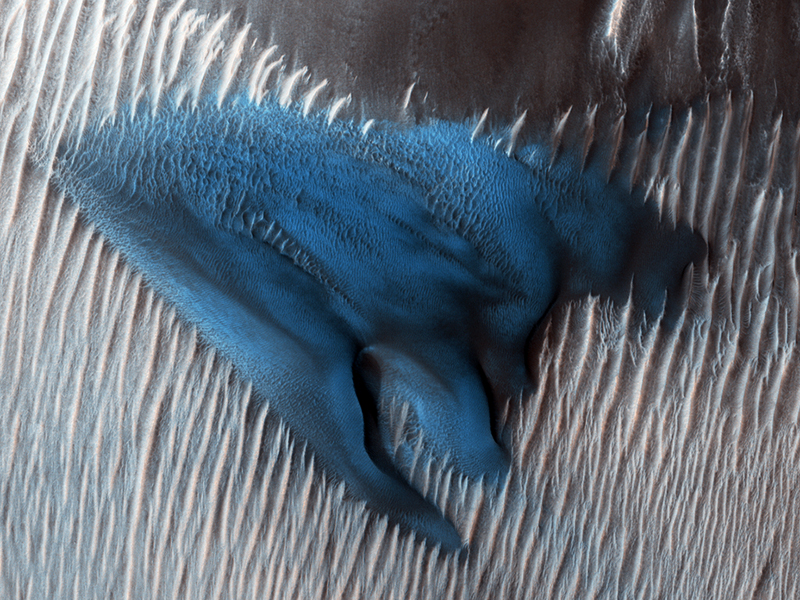HiRISE Updates Week of 2018 Jun 11
Posted: Tue Jun 12, 2018 4:27 pm
Ingrid Daubar wrote:Bang and Whoosh! (ESP_054066_1920)
This HiRISE image captures a new, dated (within about a decade) impact crater that triggered a slope streak. When the meteoroid hit the surface and exploded to make the crater, it also destabilized the slope and initiated this avalanche.
The crater itself is only 5 meters across, but the streak it started is 1 kilometer long! Slope streaks are created when dry dust avalanches leave behind dark swaths on dusty Martian hills. The faded scar of an old avalanche is also visible to the side of the new dark streak.
NB: Cutouts have been rotated so north is downward.
Candy Hansen wrote:Dust and Frost (ESP_053129_2650)
Sand dunes in the north polar regions of Mars show light coatings of pale orange dust blown partially across the dark basaltic sand. Around the edges of the dunes, patches of seasonal dry ice remain.
These patches will be gone soon as they sublimate (turn from ice to gas) in the summer sun. Some blocks of ice are visible at the foot of an alcove formed by a sand avalanche down the slipface of the dune.
Alfred McEwen wrote:A Volcano of Mud or Lava? (ESP_054649_1665)
This image shows a hill with a central crater. Such features have been interpreted as both mud volcanoes (really a sedimentary structure) and as actual volcanoes (the erupting lava kind). They occur on the floor of Valles Marineris below a closed topographic contour that could have held a lake, and the compaction of wet sediments may have created mud volcanoes.
The fracture pattern of the bright flow unit surrounding the hill resembles mud cracks. However, there have also been observations from the CRISM instrument interpreted as high-temperature minerals, suggesting actual volcanism, although not necessarily at this location. Fine layers in the hill are consistent with either volcanism or mud flows.
Either way, this activity is relatively recent in geologic time and may mark habitable subsurface environments.
Candy Hansen wrote:Once in a Blue Dune (ESP_053894_2295)
Sand dunes often accumulate in the floors of craters. In this region of Lyot Crater there is a field of classic barchan dunes.
Just to the south of the group of barchan dunes is one large dune with a more complex structure. This particular dune, appearing like turquoise blue in enhanced color, is made of finer material and/or has a different composition than the surroundings.
This is a stereo pair with ESP_053406_2295.
Credit: NASA/JPL-Caltech/University of Arizona
<< Previous HiRISE Update



